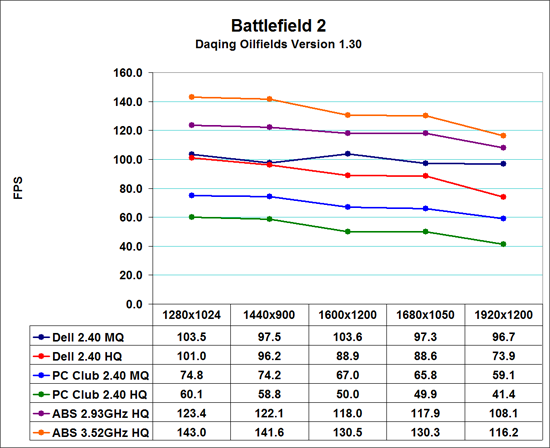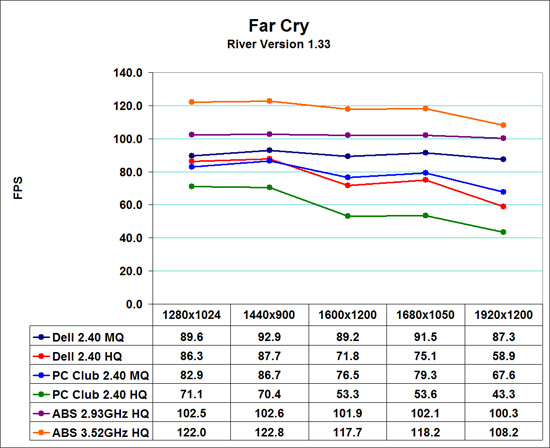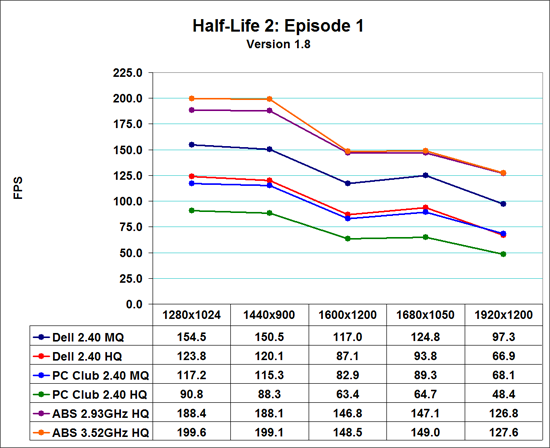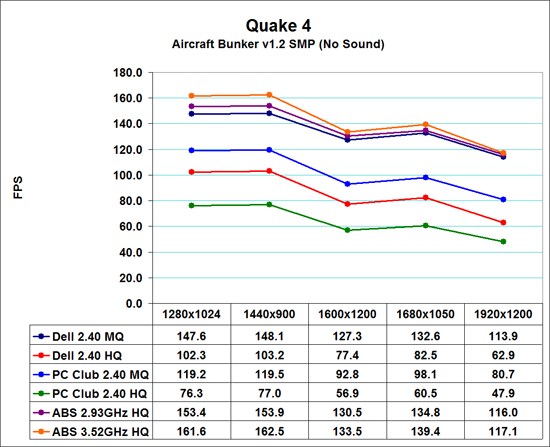Dell XPS 410: Core 2 Duo for the Masses
by Jarred Walton on September 18, 2006 12:20 PM EST- Posted in
- Systems
Gaming Resolution Scaling
As this is a system review, we will look at the gaming performance that can be achieved using the XPS 410 at lower resolutions and/or detail settings. We tested the five most commonly used resolutions for modern LCD displays at "high" and "medium" settings. We have provided a chart below of the test settings used for "medium quality" and "high quality" in each game. Here are the results from all three tested systems. All of the results are with sound enabled where possible, as this is how most people play games and it reflects testing the performance of the entire package rather than individual components.






The ABS Ultimate X9 continues to be the fasted tested system that we have reviewed, especially at higher detail settings. The ABS Ultimate X9 was not tested without antialiasing (except in Oblivion and SS2 due to the use of HDR), as performance is more than acceptable so there's no need to drop detail levels. The Sabre Extreme on the other hand can definitely benefit by running at slightly reduced detail settings, especially at higher resolutions. The chief difference between the Sabre Extreme and the XPS 410 is the graphics card, and the fact that the 7900 GTX is faster than the 7900 GT is not at all surprising. If you're wondering how the XPS 410 with a 7900 GS would perform, the reduction in the number of pipelines will reduce performance slightly relative to the 7900 GT in the PC Club Sabre Extreme, but for the most part the two cards would perform very similarly.
Even the fastest system is running into GPU limitations, so the performance benchmarks here essentially amount to comparing different GPUs. At present, the vast majority of games depend more on graphics performance than CPU performance, so with the exception of flight simulators and certain strategy games, GPU performance really does equate to gaming performance. If you need help deciding whether or not you should upgrade the graphics card in a prebuilt system, you can always refer to our video card reviews. Perhaps future games will be able to place more of a burden on the CPU, but that doesn't appear too likely, as games like Unreal Tournament 2007 and the recently released Prey appear to be more GPU limited than current titles.
The choice of graphics card is going to depend in a large part on your choice of display. If you plan on getting a standard 19 inch display -- widescreen or not -- a 7900 GT or 7900 GS will be plenty powerful for the majority of games. With larger displays, running at the native LCD resolution will require more graphics power, and you can see the advantage that the Dell XPS 410 holds over the Sabre Extreme due to the faster GPU. Disabling some of the graphical complexity can help improve frame rates on lower end GPUs, but eventually we will reach the point where faster hardware is going to be required.
DirectX 10 and Windows Vista are both due out in early 2007, and we expect them to usher in a new era of GPU performance. Until then, the GeForce 7900 GS strikes a good balance between price and performance (it would score slightly lower than the 7900 GT), while the GTX continues to be a very fast single GPU solution. However, we are certainly hesitant to recommend spending $500 or more on a DirectX 9 graphics card that will become outdated in just a few more months. If you demand more gaming performance now, consider that a GX2 can be had for almost the same amount of money as Dell charges for the 7900 GTX.
As this is a system review, we will look at the gaming performance that can be achieved using the XPS 410 at lower resolutions and/or detail settings. We tested the five most commonly used resolutions for modern LCD displays at "high" and "medium" settings. We have provided a chart below of the test settings used for "medium quality" and "high quality" in each game. Here are the results from all three tested systems. All of the results are with sound enabled where possible, as this is how most people play games and it reflects testing the performance of the entire package rather than individual components.
| Game Settings | ||
| Medium Quality | High Quality | |
| Battlefield 2 | All settings at high with 0xAA | All settings at high with 4xAA |
| Far Cry | All settings at Very High with 0xAA/8xAF Water at Ultra High |
All settings at Very High with 4xAA/8xAF Water at Ultra High |
| HL2: Episode 1 | All settings on high HDR and color correction enabled 0xAA/8xAF |
All settings on high HDR and color correction enabled 4xAA/8xAF |
| Oblivion | Ultra High Defaults (Max) except: Grass: 0% Interior/Exterior Shadows: 25% Self Shadows: Off Shadows on Grass: Off Tree Canopy Shadows: Off Shadow Filtering: Off Specular Distance: 50% HDR: On (AA: Off) |
Ultra High Defaults (Max) except: Grass: 50% Interior/Exterior Shadows: 50% Self Shadows: Off Shadows on Grass: Off HDR: On (AA: Off) |
| Quake 4 | High defaults with 0xAA SMP enabled |
High defaults with 4xAA SMP enabled |
| Serious Sam 2 | High Detail Defaults High Texture Size HDR Enabled (AA Off) |
Maximum Detail Defaults HDR Enabled (AA Off) |






The ABS Ultimate X9 continues to be the fasted tested system that we have reviewed, especially at higher detail settings. The ABS Ultimate X9 was not tested without antialiasing (except in Oblivion and SS2 due to the use of HDR), as performance is more than acceptable so there's no need to drop detail levels. The Sabre Extreme on the other hand can definitely benefit by running at slightly reduced detail settings, especially at higher resolutions. The chief difference between the Sabre Extreme and the XPS 410 is the graphics card, and the fact that the 7900 GTX is faster than the 7900 GT is not at all surprising. If you're wondering how the XPS 410 with a 7900 GS would perform, the reduction in the number of pipelines will reduce performance slightly relative to the 7900 GT in the PC Club Sabre Extreme, but for the most part the two cards would perform very similarly.
Even the fastest system is running into GPU limitations, so the performance benchmarks here essentially amount to comparing different GPUs. At present, the vast majority of games depend more on graphics performance than CPU performance, so with the exception of flight simulators and certain strategy games, GPU performance really does equate to gaming performance. If you need help deciding whether or not you should upgrade the graphics card in a prebuilt system, you can always refer to our video card reviews. Perhaps future games will be able to place more of a burden on the CPU, but that doesn't appear too likely, as games like Unreal Tournament 2007 and the recently released Prey appear to be more GPU limited than current titles.
The choice of graphics card is going to depend in a large part on your choice of display. If you plan on getting a standard 19 inch display -- widescreen or not -- a 7900 GT or 7900 GS will be plenty powerful for the majority of games. With larger displays, running at the native LCD resolution will require more graphics power, and you can see the advantage that the Dell XPS 410 holds over the Sabre Extreme due to the faster GPU. Disabling some of the graphical complexity can help improve frame rates on lower end GPUs, but eventually we will reach the point where faster hardware is going to be required.
DirectX 10 and Windows Vista are both due out in early 2007, and we expect them to usher in a new era of GPU performance. Until then, the GeForce 7900 GS strikes a good balance between price and performance (it would score slightly lower than the 7900 GT), while the GTX continues to be a very fast single GPU solution. However, we are certainly hesitant to recommend spending $500 or more on a DirectX 9 graphics card that will become outdated in just a few more months. If you demand more gaming performance now, consider that a GX2 can be had for almost the same amount of money as Dell charges for the 7900 GTX.










50 Comments
View All Comments
Gary Key - Monday, September 18, 2006 - link
BF2 is just a bit weird with the benchmark results. Although our demo contains several minutes of intense action on the Daqing Oilfield map in a variety of vehicles and personnel assignments we typically find there is very little difference in the benchmarks between 1600x1200/1680x1050 or 1920x1200/1920x1440 resolutions with a decent video card. Also, with the latest video cards like the 7900GTX or X1900 there is no penalty now for 4xAA at 1280x1024 as an example. The benchmark will score the same as we are not GPU limited at that resolution with the Dell configuration as an example.
JarredWalton - Monday, September 18, 2006 - link
BF2 also doesn't properly support WS formats except in demo playback. Go figure. So perhaps it isn't properly optimized for aspect ratios other than 1.333 (the standard for 4:3 displays).giantpandaman2 - Monday, September 18, 2006 - link
Thoroughly enjoyed it. :)Again, only suggestion would be to add how long it took between ordering and receiving.
bamacre - Monday, September 18, 2006 - link
I've been telling everyone how well-designed these cases are, and how powerful the PSU's are. I stuck an X1900 XTX card in a precision 390 with a 375W PSU, and it ran great. People don't understand wattage isn't everything.And, I totally agree, I wish case manufacturers would take a peek and learn a few things from the higher-end Dell cases.
Again, great job on the review.
yyrkoon - Monday, September 18, 2006 - link
Dell cases suck, however thier cases work for thier systems very well. Dell has always(atleast for the last several years) had innovative ways of cooling thier systems, I'm a bit surprised I even saw a radiator in this system, because normally, with a normal heatsink, and thier exaust shroud, thier systems run pretty dahmed cool.Anyhow, if you REALLY think thier cases are great, buy a Lian Li, then think on it again :) All it takes for me to realize it sucks, is to look at the back of the case, and notice how cheap it is.
Dell makes great computers for people who dont want to build thier own systems, however, for those of us who do build our own systems, I think all of us would agree, that nothing is better than a hand built system. You wont, however, be able to beat Dell prices (latest Dell catelog showed thier rock bottom system selling for $399 us, including a 17" LCD !)
mino - Monday, September 18, 2006 - link
For sinle C2D, 2sticks generi DDR2, single X1900XTX, dual HDD and dual optical ANY _properly_designed_ 350W PSU is sufficient.The real issu is, these times 300W != 300W, thats the real issue.
As a fact wattage matters, however the real one, not the written one...
kristof007 - Monday, September 18, 2006 - link
I really enjoyed reading through the review. So I was wondering would you be able to take that supporting piece off the 7900 and snap it onto a gfx card you buy?JarredWalton - Monday, September 18, 2006 - link
The blue plastic is basically made to hold a GPU in place and it should work with any standard GPU. Some specialized cooling solutions won't fit most likely, but I did slot in an X1900XT card and it fit without problems.Homerboy - Monday, September 18, 2006 - link
I'm so sick of the standard, anti-big-box-company rhetoric that's thrown aroung the Anantech Forums. Maybe this will quiet their tone.mino - Monday, September 18, 2006 - link
In the US, Absolutelly True.Here, in Slovakia, Central Europe, NO.
Simply because the smaller the market, the more expensive the Dell and the worse the support.
We buy no pre-built ones since the for a price on an low-end pre-build I can have mid-to-high end custom build.
And local support -if knowledgeable- is FAR more effective and responsive that any DELL's. Not to mention cheaper, since most HW issues are warrantied even on customs. The real problem's are HW-SW and SW and most of these are not warrantied by anybody, so you are gonna solve them by yourself or pay huge sums for paid support.
Here the ~$200 per incident from big players is outrageous. Such can pay me 2-3 days of on-site professional's salary. And I need that professional no matter what.
Those Dell's prices are cute, if one forgets they ask $1000 here for the same machine sold at $500 in US... That puts thing a bit into the perspective.
Also to maintain an stable of a few hundred of those machines >3yrs often becomes a real pain.
Reason being 1GHz/512M Athlon/PIII from 2001 is still pretty sufficient for most of the tasks these days, also budgetary constriants are never predictable...
As of now, I simply buy 30% motherboards above the PC count and I'm pretty nicely covered for 5+yrs. 3yrs is warranty, and after that I have own spare parts stacked up nicely on the self.
Any other part is a comodity thingie, som almost no stockpile needed.
This way we can repair any HW failure within minutes of diagnose and if needed pretty comfortably operate for a few yers under seriosly limited budget.
So for me - screw the Dell's of this world :)